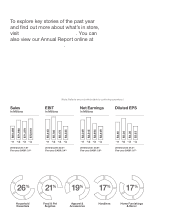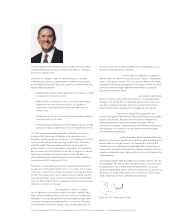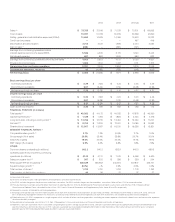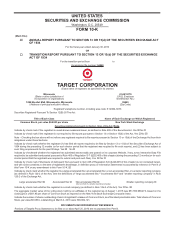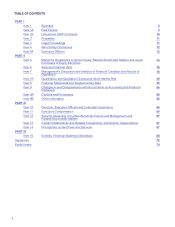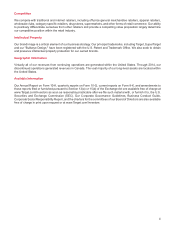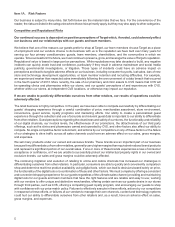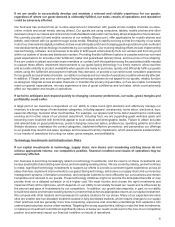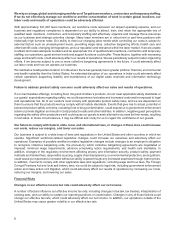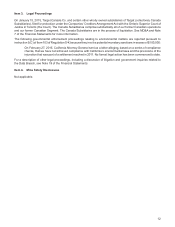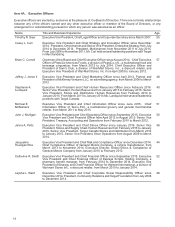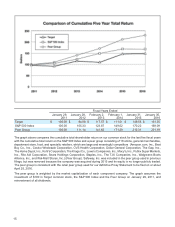Target 2015 Annual Report Download - page 10
Download and view the complete annual report
Please find page 10 of the 2015 Target annual report below. You can navigate through the pages in the report by either clicking on the pages listed below, or by using the keyword search tool below to find specific information within the annual report.
Item€1A.€€€€Risk Factors
Our business is subject to many risks. Set forth below are the material risks that we face. For the convenience of the
reader, the risks are listed in the categories where those risks primarily apply, but they may also apply to other categories.
Competitive and Reputational Risks
Our continued success is dependent on positive perceptions of Target which, if eroded, could adversely affect
our business and our relationships with our guests and team members.
We believe that one of the reasons our guests prefer to shop at Target, our team members choose Target as a place
of employment and our vendors choose to do business with us is the reputation we have built over many years for
serving our four primary constituencies: guests, team members, shareholders, and the communities in which we
operate. To be successful in the future, we must continue to preserve, grow, and leverage the value of Target's reputation.
Reputational value is based in large part on perceptions. While reputations may take decades to build, any negative
incidents can quickly erode trust and confidence, particularly if they result in adverse mainstream and social media
publicity, governmental investigations, or litigation. Those types of incidents could have an adverse impact on
perceptions and lead to tangible adverse effects on our business, including consumer boycotts, lost sales, loss of new
store and technology development opportunities, or team member retention and recruiting difficulties. For example,
we experienced weaker than expected sales immediately following the announcement of a data breach that occurred
in the fourth quarter of 2013. More recently, the sale of our pharmacy and clinic assets to CVS means that CVS will
be operating clinics and pharmacies within our stores, and our guests’ perceptions of and experiences with CVS,
whether within our stores, at independent CVS locations, or otherwise may impact our reputation.
If we are unable to positively differentiate ourselves from other retailers, our results of operations could be
adversely affected.
The retail business is highly competitive. In the past, we have been able to compete successfully by differentiating our
guests’ shopping experience through a careful combination of price, merchandise assortment, store environment,
convenience, guest service, loyalty programs and marketing efforts. Our ability to create a personalized guest
experience through the collection and use of accurate and relevant guest data is important to our ability to differentiate
from other retailers. Guest perceptions regarding the cleanliness and safety of our stores, the functionality and reliability
of our digital channels, our in-stock levels, the effectiveness of our promotions, the attractiveness of our third party
offerings, such as the clinics and pharmacies owned and operated by CVS, and other factors also affect our ability to
compete. No single competitive factor is dominant, and actions by our competitors on any of these factors or the failure
of our strategies to drive traffic across all sales channels could have an adverse effect on our sales, gross margins,
and expenses.
We sell many products under our owned and exclusive brands. These brands are an important part of our business
because they differentiate us from other retailers, generally carry higher margins than equivalent national brand products
and represent a significant portion of our overall sales. If one or more of these brands experiences a loss of consumer
acceptance or confidence, or if we are unable to successfully protect our intellectual property rights in our owned and
exclusive brands, our sales and gross margins could be adversely affected.
The continuing migration and evolution of retailing to online and mobile channels has increased our challenges in
differentiating ourselves from other retailers. In particular, consumers are able to quickly and conveniently comparison
shop and determine real-time product availability using digital tools, which can lead to decisions based solely on price,
the functionality of the digital tools or a combination of those and other factors. We must compete by offering a consistent
and convenient shopping experience for our guests regardless of the ultimate sales channel; providing and maintaining
digital tools for our guests and team members that have the right features and are reliable and easy to use; working
with our vendors to offer unique and distinctive merchandise, offering certain services our guests desire in our stores
through third parties, such as CVS, offering a compelling guest loyalty program, and encouraging our guests to shop
with confidence with our price-match policy. Failures to effectively execute in these efforts, actions by our competitors
in response to these efforts, or failures of our vendors to manage their own channels, content and technology systems
could hurt our ability to differentiate ourselves from other retailers and, as a result, have an adverse effect on sales,
gross margins, and expenses.
5


